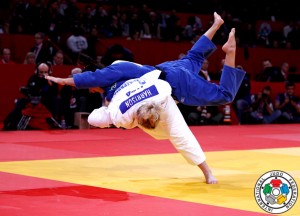
For years, Kayla Harrison has had two main goals in life: to be World Champion in Judo and to be Olympic Champion. She achieved her first goal in 2010 when she became the first woman in American Judo History to win the World Championships since 1984. She was only 19 years old.
This year Kayla will attempt to achieve her second goal of becoming Olympic Champion when she competes at the London Olympic Games on August 2.
NBC has already dubbed her one of the US’s Top 5 Newcomers of the Games and she’s already been featured in Sports Illustrated and USA Today.
Kayla took time out of her busy schedule to talk with Humintell about how she stays motivated, handles stress and maintains positivity.
Q. How old were you when you started judo and why did you choose this sport?
I started judo when I was 6 years old. My mom had done judo in college and wanted me to learn self defense.
Q. When did you realize you wanted to become an Olympian?
It probably was around when I was 13 years old and I started competing on the Senior level. When I moved to Boston when I was 16 to train with (former World Champion and two-time Olympic Bronze Medalist) Jimmy Pedro, I realized that this dream was probably a reality.
Q. What does your workout regime consists of now?
I train full time. I practice judo two times a day, once in the morning and once in the evening. Three days a week I do some running and five days a week I lift (weights). I do this six times a week.
Q. With such an exhausting schedule, how do you motivate yourself to workout when you don’t want to?
One of my favorite quotes is “First you fuel the desire then the desire will fuel you”. I think that’s really true.
I put in a lot of work when I was younger and hard work was instilled in me at a young age. I know what I have to do to win an Olympic Gold Medal and it’s something I’ve wanted for so long that now the desire fuels me. Goals have always been a huge motivator for me. Now that I’m closer than ever to achieving one of my biggest goals, that desire is even stronger. Judo is an individual sport, not a team sport so when you lose there is no one to blame except yourself. I figure, pay now or pay later. I choose to pay now.
Q. Do you get nervous, anxious, or stressed out before tournaments?
I definitely get stressed and nervous before competition. I think if I didn’t get nervous, there would be something wrong with me. I think it’s good to have some nerves. But the older I’ve gotten and the more I’ve competed at a high level, it’s easier to deal with those stressful emotions. You get better at handling them.
(Former teammate and now MMA star) Ronda (Rousey) told me about “two week itis” and it’s totally true. Two weeks out from a major tournament I get very emotional. I’m physically and mentally exhausted.
Q. How do you deal with that anxiety before competition?
Usually when this happens, I sit down and tell myself that this happens every time and that it’s okay. Usually I cry and it makes me feel better. Then I try to focus on the little things like packing my bag or reading a book. Focusing on the little day to day things help me not be overwhelmed by the stress.
Q. We heard you also do some visualization. Can you explain this a little more for us?
Sure. Every night before I go to bed I do about 10 minutes of visualization. I visualize myself at the Olympics: weighing in, what I’m going to eat for breakfast, taking the bus to the venue, warming up. I visualize getting my gi (judo uniform) checked, doing my breathing techniques, and every match until the finals. I visualize who I’ll likely fight in the finals and different ways I could win. I see myself on the podium with a gold medal around me neck, seeing the American flag and hearing our national anthem playing.
Q. You mentioned some breathing techniques. What specifically do you do and why do you do this?
I do my breathing techniques to calm my nerves and relax right before I step on mat. I do this because right before you compete you get a huge surge of adrenaline. I find that if I’m too amped up, I don’t perform as well. So before I go out there, I take 3-5 deep breaths, hold it, and exhale slowly. It calms and centers me and strategically I can fight much better.
Q. Do you find that letting your emotions take over you can affect your performance?
Definitely. In judo you can win or lose in a fraction of a second. I’m a methodical, strategic planner. If I go out there with my guns blazing, I tend to make mistakes and it’s hard to catch up. That’s not the way I want my matches to go. I know I want to fight in a certain way. Letting my emotions get to me affects my strategy and the way I want to fight.
Q. What techniques can you suggest to the average person to help calm their nerves or ease stress in their life?
No matter what you do, I believe the techniques that I use such as deep breathing and visualization can definitely be used in every day life. I know that I’ve used them outside of judo. If I’m about to go onstage and do a judo demonstration or about to speak in front of the New York Athletic Club (NYAC), I know that taking a few deep breaths helps center me and think a little more clearly. I’m a huge believer in positive thinking. When you are stressed out about something, thinking positively about it is definitely going to help you. Using those techniques: taking deep breaths, positive thinking, visualization can be helpful in any area of life.
To learn more about Kayla, become a fan of her Facebook Page, follow her on Twitter and visit her website
 Management-issues.com has delved into the complex world of cultural relations.
Management-issues.com has delved into the complex world of cultural relations. Where were you yesterday at 3:45pm? Don’t lie we have your finger prints. Why did you commit this crime?
Where were you yesterday at 3:45pm? Don’t lie we have your finger prints. Why did you commit this crime?